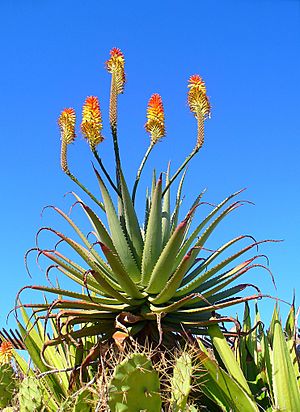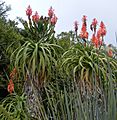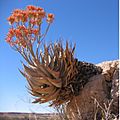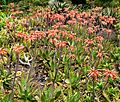Aloe facts for kids
Aloe is a type of plant with thick, fleshy leaves. There are over 500 different kinds, or 'species,' of Aloe. The most famous one is probably Aloe vera. People grow it all over the world. It might not even grow naturally in the wild anymore.
Aloe plants originally came from warm places like southern Africa, Madagascar, and the Arabian Peninsula. You can also find them on islands in the Indian Ocean. Now, some types of Aloe grow naturally in other parts of the world too, like around the Mediterranean Sea, in India, Australia, and the Americas.
What are Aloe Plants Like?
Most Aloe plants have their big, thick, fleshy leaves arranged in a circle, like a flower. Their flowers look like tubes and are often yellow, orange, pink, or red. These flowers grow in tight bunches at the top of tall, bare stems.
Many Aloe species seem to grow right out of the ground without a visible stem. Other types might have a branched or unbranched stem from which their fleshy leaves grow. Their leaves can be different colors, from gray to bright green. Sometimes they have stripes or spots. Some Aloe plants from South Africa can even grow as tall as trees!
How Do People Use Aloe?
People often grow Aloe species as decorative plants. They look great in gardens and in pots inside homes. Many types of Aloe are very pretty. Collectors who love succulent plants really value them.
Aloe vera is used on and in humans. Some studies suggest it has helpful effects. It can also be used to make special soaps or other natural skin care products.
People have used different Aloe species for a long time. Out of over 500 species, only a few were traditionally used as herbal medicines. Aloe vera was the most common one. The Ancient Greeks and Romans used Aloe vera to help treat wounds.
Some species, especially Aloe vera, are used in alternative medicine and for first aid. The clear gel from inside the leaf and the yellow liquid from a wounded plant are both used on the skin for discomforts. As an herbal medicine, Aloe vera juice is often used for digestive issues.
Images for kids
-
Succulent plants, like this aloe, store water in their enlarged fleshy leaves, stems, or roots, as shown in this split aloe leaf. This helps them survive in dry places.
-
Multiple Aloe species with a variety of growth forms. UCLA Botanical Garden
-
Depiction of Aloe, labeled in Greek "ΑΛΟΗ" (Aloë) from the Juliana Anicia Codex, a copy, written in Constantinople in 515 AD, of Dioscorides' 1st century AD work.
-
Aloe africana (Uitenhage aloe)
See also
 In Spanish: Áloe para niños
In Spanish: Áloe para niños





















